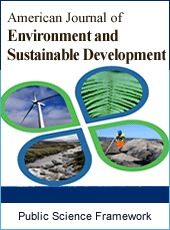American Journal of Environment and Sustainable Development
Articles Information
American Journal of Environment and Sustainable Development, Vol.6, No.1, Mar. 2021, Pub. Date: Jan. 22, 2021
Evaluation of Guinea Corn (Sorghum bicolor L.) Chaff for Production of Bioethanol
Pages: 8-14 Views: 1676 Downloads: 1119
[01]
Daramola Busayo Mary, Department of Chemistry, School of Sciences, Federal University of Technology, Akure, Nigeria.
[02]
Ogunsuyi Helen Olayinka, Department of Chemistry, School of Sciences, Federal University of Technology, Akure, Nigeria.
[03]
Adelaja Adekoya Oluwaseun, Department of Chemistry, School of Sciences, Federal University of Technology, Akure, Nigeria.
[04]
Ayoko Oladipupo Oluwanisola, Department of Chemistry, School of Sciences, Federal University of Technology, Akure, Nigeria.
Guinea corn chaff was pre-treated by screening and ultrasonication processes. Fiber fraction analysis of the untreated and treated chaffs were determined using fibertex analyser. Hydrolysis of the sample was carried out with 4% w/v sulphuric acid and the hydrolysate analysed for monomeric sugars (glucose, xylose, arabinose) using High Performance Liquid Chromatography. The hydrolysed sample was fermented for 5 days to produce bioethanol. Bio-CaO produced from waste fruit was used for purification of the bioethanol produced. Surface morphology and structural composition of the pre and post hydrolysed chaffs were studied. The fuel properties of the bioethanol were carried out and characterised with FTIR. Pre-treatment result in fractional increase in fiber content of 74.96%. Neutral detergent and acid detergent fibers recorded for the untreated and treated chaffs were 74.36%, 74.56%, 29.40% and 29.20% respectively. Hemicellulose content recorded for the untreated and treated chaffs were 44.96% and 45.36%. The result of the hydrolysis using HPLC for monitoring the release of the monomeric sugars were established at 1:5 liquor ratio and 1.21 micrometre particle size. The surface morphology of the sample showed an organised and rupture surface before and after hydrolysis. The fuel properties of the bioethanol conform to the standard values. These results obtained suggests that guinea corn chaffs are good feedstock for bioethanol.
Renewable Energy, Biofuel, Bioethanol, Fibertex, Analyser, Monomeric, Hemicellulose Biomass, Fermented
[01]
Bhattacharya, M.; Paramati, S.R.; Ozturk, I.; Bhattacharya, S. The e_ect of renewable energy consumption on economic growth: Evidence from top 38 countries. Appl. Energy 2016, 162, 733–741.
[02]
Tulloch J. (2011). Raising the Next Generation.
[03]
Mutegi E., Fabrice S., Moses M., Ben K., Bernard R., Caroline M., Charles M., Joseph K., Heiko P., Santie D., Kassa S., Pierre T. and Maryke L. (2011). "Ecogeographical distribution of wild, weedy and cultivated Sorghum bicolor (L.) Moench in Kenya: implications for conservation and crop-to-wild gene flow". Genetic Resources and Crop Evolution. 57 (2): 243–253.
[04]
Guo, Y.Y.; Tian, S.S.; Liu, S.S.;Wang,W.Q.; Sui, N. Energy dissipation and antioxidant enzyme system protect photosystem II of sweet sorghum under drought stress. Photosynthetica 2018, 56, 861–872.
[05]
Centre for plant breeding (2011). Sweet sorghum production technology. Department of millet, Centre for plant breeding and genetics, Tamil Nadu Agricultural University, India. p.2.
[06]
Serra, P.; Giuntoli, J.; Agostini, A.; Colauzzi, M.; Amaducci, S. Coupling sorghum biomass and wheat straw to minimise the environmental impact of bioenergy production. J. Clean. Prod. 2017, 154, 242–254.
[07]
Wannasek, L.; Ortner, M.; Amon, B.; Amon, T. Sorghum, a sustainable feedstock for biogas production? Impact of climate, variety and harvesting time on maturity and biomass yield. Biomass Bioenergy 2017, 106, 137–145.
[08]
Association of Official Chemist (AOAC) (2002). Treated neutral detergent fiber in feeds using refluxing in beakers or crucible. AOAC International. Gaithersbury, MD (USA): Association of Analytical Communities.
[09]
Dania A. F., Robert L., David T., Mayank G. and Jagannadh S. (2014). "Towards integrated bio-refinery from dried distiller grains: Selective extraction of pentoses using dilute acid hydrolysis. Biomass and Bioenergy, 71: 178-86.
[10]
Armanul N., Shafkat S., Rahman M., Mahboob H. and Naiyyum C. (2016). Isolation of Saccharomyces cerevisiae from pineapple and orange and study of matal’s effectiveness on ethanol production. European Journal of Microbiology and Immunology, 7(1).
[11]
Ayoola A. A., Igho B. E., Babalola R., Ojewumi M. E., Ajibola B. R., Young J. S. and Hanley T. R. (2006). Reintroduced solids increase inhibitor levels in a pre-treated corn stover hydrolysate. Applied Biochemical Biotechnology. 129–132, 612–620.
[12]
Association of Official Chemist (AOAC), (2001). Official Method of Analysis. Protein (crude) in animal feed, forage (Plant tissue), grain and oil seeds. AOAC International. Gaithersbury, MD (USA) 17th Edition 11.
[13]
Ivone T., Filipa B., Anatoly A., Florbela C. and Luis C. (2014). The impact of particle size on the dilute acid hydrolysis of giant reed biomass. Electronic Journal of Energy and Environment 2 (1):1-9.
[14]
Tune M. (2014). Effect of liquid to solid ratio on autohydrolysis of eucalyptus globulus wood meal. Bioresources Biotechnology. 9 (2), 30145-3024.
[15]
Rinyngu C., Njehia B. and Mutai B. (2014). Effects of supermarkets on fresh fruit and vegetables small-scale farmers in central Kenya. Sky Journal of Business Administration and Management. 1 (5): 47-58.
[16]
Ogunsuyi H. O. and Badiru A. (2016). Production and chemical evaluation of bioethanol derived from white cocoyam (Colocasia Antiquorium) and sweet potatoes (Ipomea Batatas) cultivars. International Journal of Advanced Scientific Research and Management, (1) 7, 209-210.
[17]
Moorthy S. N. (2002). Physicochemical and functional properties of tropical tuber starches: A review. 54:559–592.
[18]
Khusna W. and Endah N. H. (2019). Analysis and characterization of bioethanol from banana (Musa Acuminata Balbisiana) peel pulp by yeast enzymatic production. Journal of Kartika Kimia. (2): 74-77.

ISSN Print: Pending
ISSN Online: Pending
Current Issue:
Vol. 6, Issue 4, December Submit a Manuscript Join Editorial Board Join Reviewer Team
ISSN Online: Pending
Current Issue:
Vol. 6, Issue 4, December Submit a Manuscript Join Editorial Board Join Reviewer Team
| About This Journal |
| All Issues |
| Open Access |
| Indexing |
| Payment Information |
| Author Guidelines |
| Review Process |
| Publication Ethics |
| Editorial Board |
| Peer Reviewers |


